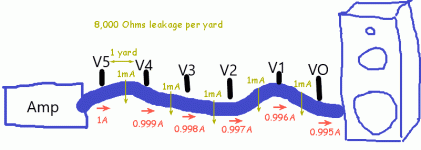I wondered what the point of this thread was going to turn out to be, having started so badly with the OP making false and confused statements about simple circuits, and I wondered where I had come across him before. Thanks to Scottmoose for reminding me.
To define a symetry between two potentials, a third potential is needed.
The voltage at the connections of a little single element 1.5 V battery is never said to be symetrical. It is floating.
The voltage at the connections of a little single element 1.5 V battery is never said to be symetrical. It is floating.
Don't bother, this thread was about "directional" wire all alongTo define a symetry between two potentials, a third potential is needed.
The voltage at the connections of a little single element 1.5 V battery is never said to be symetrical. It is floating.
...you measure the current at any point on the cable, the current is the same...
No it is not.
Every cable has both series resistance and shunt resistance. Polyethylene is not a perfect insulator; nothing is (not even empty space).
Say you start from 8V 1 Amp into the cable. And say the cable has the (unlikely large) leakage of 8,000 Ohms per yard, and cable is 5 yards. You actually get 0.995A to the load and 5mA leaking through the poly.
(Actually the voltage is dropping so the mA/yard falls off, but in a "reasonable" cable this is small.)
Since you are interested in the subject, I assume by now you can work the
Telegrapher's Equation backward and forward.
Attachments
For audio freq., the leakage current from the conductor to ground (through dielectric material) is fairly small unless it is a really badly designed cable. Conceptually, the current in a loop is the same. For high freq., sure there are parasitic paths that the current can flow that can be hard to predict but the current has to obey the loop rule or the sum at any node should be zero.
Anyway, what you said interesting (and it will make the haters in this thread here frown) is that even the AC current is directional because like you said, the current starts out high then due to loses, it will be less and less at the load due to leakage and other stuffs. So even the current is AC, it is not symmetric. So now you just prove that even AC current is directional 😀
Anyway, what you said interesting (and it will make the haters in this thread here frown) is that even the AC current is directional because like you said, the current starts out high then due to loses, it will be less and less at the load due to leakage and other stuffs. So even the current is AC, it is not symmetric. So now you just prove that even AC current is directional 😀
Last edited:
...So now you just prove that even AC current is directional 😀
Your understanding of directionality and symmetry is too transcendental for me.
- Status
- Not open for further replies.
- Home
- Member Areas
- The Lounge
- Symmetric circuit (or not) then to a more difficult question


 Thread closed for maintenance.
Thread closed for maintenance.